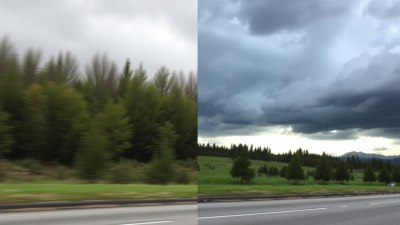The Connection Between Wind and Pressure
Explore the relationship between wind and atmospheric pressure in this detailed analysis.

This image was created with the assistance of Freepik
Understanding the connection between wind and pressure is a foundational concept in meteorology, affecting weather patterns and climate systems.
The Basics of Atmospheric Pressure
Atmospheric pressure, also known as air pressure, is the force exerted onto a surface by the weight of the air above that surface in the atmosphere of Earth (or that of another planet). It is commonly measured in units such as Pascals (Pa), millibars (mb), or inches of mercury (Hg). At sea level, the average atmospheric pressure is about 1013.25 hPa (hectopascals), which serves as the reference point for pressure measurement.
What Causes Air Pressure Variations?
Pressure variations occur due to several factors including temperature changes, altitude differences, and humidity levels. As the temperature increases, air molecules become more energetic and spread apart, resulting in lower density and lower pressure. Conversely, cooler air is denser, leading to higher pressure. Additionally, altitude plays a significant role; as elevation increases, the amount of air above decreases, which also lowers the pressure. Variations in humidity affect air density and subsequently influence pressure readings as well. For instance, moist air is lighter than dry air, thereby affecting the overall pressure determination.
The Formation of Wind
Wind is the movement of air from areas of high pressure to areas of low pressure. It is generated by the uneven heating of the Earth's surface by the sun, which creates thermally-induced pressure differences. Land and water heat up at different rates; land heats quickly during the day, causing air above to rise and create lower pressure conditions. This, in turn, draws in cooler, denser air from adjacent areas of higher pressure, thus generating wind. The strength of wind is influenced by the pressure gradient—the difference in pressure between two areas over a distance. A steep gradient results in stronger winds, while a gentle gradient corresponds to lighter winds.
The Coriolis Effect
The Coriolis effect is a critical factor in how wind circulates on Earth. Due to the planet's rotation, moving air is deflected to the right in the Northern Hemisphere and to the left in the Southern Hemisphere. This deflection is significant in determining wind patterns, such as the trade winds, westerlies, and easterlies, and is governed largely by the balance between pressure gradients and the Coriolis effect. The result is a complex system of wind currents that help distribute heat and moisture around the globe, playing an essential role in overall climate regulation.
High and Low-Pressure Systems
Pressure systems play an important role in dictating weather. High-pressure systems, characterized by descending air, typically lead to clear skies and stable weather conditions, as the air sinks and inhibits cloud formation. Conversely, low-pressure systems are associated with rising air, leading to cloud formation and precipitation. Therefore, tracking these systems is crucial for weather forecasting and understanding atmospheric phenomena.
Weather Fronts and Wind
Weather fronts are boundaries between air masses of different temperatures and humidity levels. When a cooler air mass meets a warmer one, the denser cool air tends to slide underneath, leading to upward movement of the warm air. This process often leads to cloud formation and precipitation. The wind is not only influenced by the pressure difference between these air masses but also by the movement of the fronts themselves. For instance, as a cold front approaches, the wind direction may shift, bringing changes in temperature and precipitation.
Effects of Topography on Wind and Pressure
Topography, or the physical landscape of an area, can significantly influence wind patterns and pressure. Mountains can block or channel winds, creating phenomena such as chinooks or mountain breezes. When wind encounters a mountain range, it is forced upward, cooling and condensing as it rises, often resulting in precipitation on the windward side, while the leeward side can experience dry conditions, known as rain shadows. This interaction between wind and topography illustrates the complexity of atmospheric dynamics.
The Role of Ocean Currents
Ocean currents also have a profound impact on wind patterns and pressure systems. The interaction between ocean surface temperatures and the atmosphere influences local and regional climates. For instance, warm ocean waters can amplify low-pressure systems, leading to more vigorous storm activity. Conversely, cold currents can stabilize the atmosphere, leading to higher pressure and drier conditions. Understanding these interactions is critical for predicting weather and climate changes.
Climate Change and Its Impact on Wind Patterns
Climate change affects wind patterns and pressure systems globally. As global temperatures rise, the distribution of pressure zones may shift, altering precipitation patterns and impacting ecosystems and human activities. The effects of climate change can also lead to more extreme weather events, driven by changes in the strength and frequency of storms associated with low-pressure systems. Meteorologists and climate scientists continually study these shifts to inform about potential future impacts.
In summary, the connection between wind and pressure is a key element in understanding meteorological phenomena. As wind moves from areas of high to low pressure, it plays a vital role in shaping weather patterns across the globe. Factors such as temperature, humidity, and altitude significantly affect atmospheric pressure, creating the conditions for wind formation. Additionally, the Coriolis effect and the influence of geographic features add layers of complexity to this relationship. As we face the challenges posed by climate change, a thorough understanding of these dynamics will be essential in preparing for future weather-related events and shifts in climate.











